Ijraset Journal For Research in Applied Science and Engineering Technology
- Home / Ijraset
- On This Page
- Abstract
- Introduction
- Conclusion
- References
- Copyright
Exploring Deflection Characteristics of Externally Reinforced PCC Beams Using ANSYS: A Comparative Study of Bonded Steel Plate Applications with Different Grades of Concrete
Authors: Shruti Vaidya, Dr. Umesh Pendharkar
DOI Link: https://doi.org/10.22214/ijraset.2024.64082
Certificate: View Certificate
Abstract
The deflection characteristics of externally reinforced plain cement concrete (PCC) beams using ANSYS are studied, representing a significant exploration in civil engineering. The ultimate behaviour of PCC beams enhanced with external reinforcement is analyzed, with a particular focus on their deflection properties under varying loading conditions. After gaps in the literature are identified, objectives such as the selection of deflection parameters, the use of FEM modeling to assess behavior, and the application of steel plate retrofitting methods across different beam faces are outlined. The effects of different thicknesses of retrofitted steel plates and varying grades of concrete are examined, categorized into findings under Part A and Part B. Part A evaluates the impact of bonding steel plates, both with and without their application, while Part B compares results based on grade change criteria. Simulation results are analyzed, and conclusions are drawn, revealing that PCC beams perform optimally when reinforced with varying thicknesses of external steel plates alongside different concrete grades, resulting in reduced deflection under applied loads.
Introduction
I. INTRODUCTION
In the field of civil engineering, the retrofitting of existing structures is a crucial practice aimed at enhancing the load-carrying capacity, durability, and overall performance of buildings and infrastructure. Among the various retrofitting techniques available, the steel plate bonding method stands out as a highly effective and versatile approach. This method involves the application of steel plates to the surface of structural elements, such as beams, columns, and slabs, to improve their mechanical properties and extend their service life. The external reinforcing makes it more durable in case when PCC beam has used.
There are many methods/techniques available for the strengthening of the structural members so that they can improve its performance and withstand heavy loads with its extended service life. They are shown in the figure 1 below:-

Fig. 1: Strengthening techniques of the structural members
II. RESEARCH OBJECTIVES
Considering the outlined problem statement and aiming to propose new research addressing it, the following objectives have been selected:
- To investigate the behavior of a Precast Cement Concrete beam member, focusing on deflection parameters.
- To analyze the internal and external behavior of the flexural member using ANSYS software, employing Finite Element Modeling (FEM) with specified boundary conditions.
- To evaluate the effectiveness of steel plate retrofitting applied to different faces of the beam member through comparative analysis.
- To enhance the flexural capacity of a beam in service through retrofitting, examining the response of the flexural member under varying thicknesses of retrofitted steel plates.
- To assess the influence of member stiffness on its behavior under load, extending the study to analyze flexural members composed of different concrete grades.
This study has distributed into three findings under head Part A and Part B
a) Part A: Application of with and without usage of bonding steel plate
In this part, the comparison of the deflection behavior under different loads on PCC member with and without using bonding steel plate application over different faces has selected.
b) Part B: Comparison in terms of grade change criteria
In this part, the stiffness of the PCC members is different by using different grades of concrete.
III. PROCEDURE AND 3D MODELLING OF THE STRUCTURE
Comprehensive input data and its descriptions about the model given below. The input data used for creation of PCC beam and external reinforcement made up of steel are shown below:-
A. Constraints and Parameters
- Cross Section of Beam: The beam has a cross-sectional dimension of 200 mm by 300 mm.
- Span of Beam: The length of the beam is 3000 mm.
- Modulus of Elasticity (E): For different concrete grades, the modulus of elasticity is calculated as follows:
-
- M20: E = 22,360.679 N/mm².
- M25: E = 25,000 N/mm².
- M30: E = 27,386.127 N/mm².
- M35: E = 29,580.398 N/mm².
-
- Poisson’s Ratio
- M20: Between 0.15 and 0.20.
- M25: Between 0.18 and 0.22.
- M30: Between 0.20 and 0.25.
- M35: Between 0.22 and 0.28.
- FEM Mesh Size: The finite element mesh size used is 20 mm by 20 mm.
- Bonding Steel Plate
- Thickness: Available in 3 mm, 6 mm, and 9 mm.
- Grade: Fe 250.
- Modulus of Elasticity of Steel: 200,000 MPa.
B. Loading Data
- Dead Load
- Self-weight of the beam.
- Additional point loads applied are:- 100 kN, 200 kN, 300 kN, 400 kN and 500 kN
C. Models Framed for Analysis
- SB: Simply supported PCC (Plain Cement Concrete) beam without using a bonding steel plate.
- SB-3B: Simply supported PCC beam using a bonding steel plate of 3 mm thickness at the base.
- SB-6B: Simply supported PCC beam using a bonding steel plate of 6 mm thickness at the base.
- SB-9B: Simply supported PCC beam using a bonding steel plate of 9 mm thickness at the base.
- SB-3S: Simply supported PCC beam using a bonding steel plate of 3 mm thickness on the two side faces.
- SB-6S: Simply supported PCC beam using a bonding steel plate of 6 mm thickness on the two side faces.
- SB-9S: Simply supported PCC beam using a bonding steel plate of 9 mm thickness on the two side faces.
- SB-3BS: Simply supported PCC beam using a bonding steel plate of 3 mm thickness at the base and on the two side faces.
- SB-6BS: Simply supported PCC beam using a bonding steel plate of 6 mm thickness at the base and on the two side faces.
- SB-9BS: Simply supported PCC beam using a bonding steel plate of 9 mm thickness at the base and on the two side faces.
- SB-3BST: Simply supported PCC beam using a bonding steel plate of 3 mm thickness at the base, on the two side faces, and on the top face.
- SB-6BST: Simply supported PCC beam using a bonding steel plate of 6 mm thickness at the base, on the two side faces, and on the top face.
- SB-9BST: Simply supported PCC beam using a bonding steel plate of 9 mm thickness at the base, on the two side faces, and on the top face.
Note: here,
SB = Simply supported PCC beam
3B/6B/9B = provided Bonding Steel Plate of 3mm/6mm/9mm thickness at base
3S/6S/9S = provided Bonding Steel Plate of 3mm/6mm/9mm thickness at two side faces
3BS/6BS/9BS = provided Bonding Steel Plate of 3mm/6mm/9mm thickness at both base and at two side faces
3BST/6BST/9BST = provided Bonding Steel Plate of 3mm/6mm/9mm thickness at base, at two side faces and top face
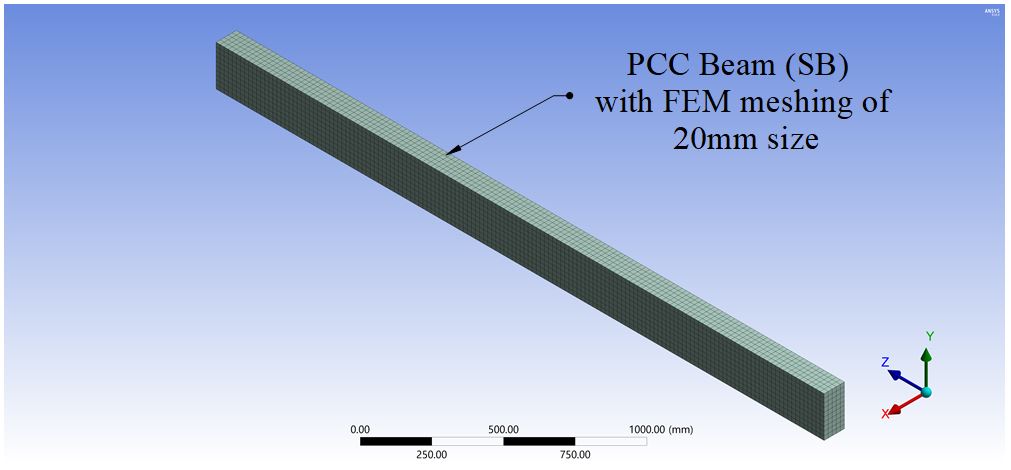
Fig. 2: 3D view of simply supported PCC beam without using bonding steel plate (SB)
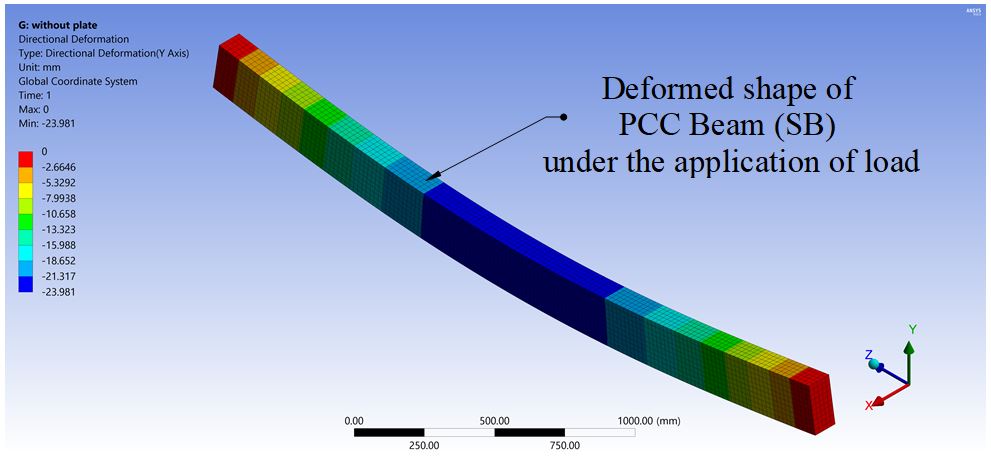
Fig. 3: Deformed view of simply supported PCC beam without using bonding steel plate (SB)

Fig. 4: 3D view of simply supported PCC beam using bonding steel plate of 3mm/6mm/9mm thickness at base (SB-3B/6B/9B)
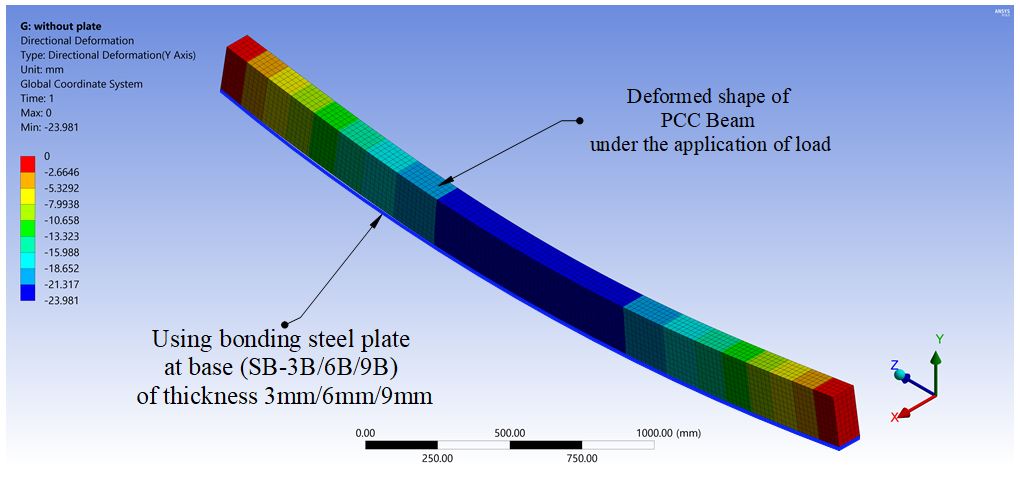
Fig. 5: Deformed view of simply supported PCC beam using bonding steel plate of 3mm/6mm/9mm thickness at base (SB-3B/6B/9B)
 Fig. 6: 3D view of simply supported PCC beam using bonding steel plate of 3mm/6mm/9mm thickness at two side faces (SB-3S/6S/9S)
Fig. 6: 3D view of simply supported PCC beam using bonding steel plate of 3mm/6mm/9mm thickness at two side faces (SB-3S/6S/9S)

Fig. 7: Deformed view of simply supported PCC beam using bonding steel plate of 3mm/6mm/9mm thickness at two side faces (SB-3S/6S/9S)
 Fig. 8: 3D view of simply supported PCC beam using bonding steel plate of 3mm/6mm/9mm thickness at base and two side faces (SB-3BS/6BS/9BS)
Fig. 8: 3D view of simply supported PCC beam using bonding steel plate of 3mm/6mm/9mm thickness at base and two side faces (SB-3BS/6BS/9BS)
 Fig. 9: Deformed view of simply supported PCC beam using bonding steel plate of 3mm/6mm/9mm thickness at base and two side faces (SB-3BS/6BS/9BS)
Fig. 9: Deformed view of simply supported PCC beam using bonding steel plate of 3mm/6mm/9mm thickness at base and two side faces (SB-3BS/6BS/9BS)
 Fig. 10: 3D view of simply supported PCC beam using bonding steel plate of 3mm/6mm/9mm thickness at base, two side faces and top face (SB-3BST/6BST/9BST)
Fig. 10: 3D view of simply supported PCC beam using bonding steel plate of 3mm/6mm/9mm thickness at base, two side faces and top face (SB-3BST/6BST/9BST)

Fig. 11: Deformed view of simply supported PCC beam using bonding steel plate of 3mm/6mm/9mm thickness at base, two side faces and top face (SB-3BST/6BST/9BST)
IV. RESULTS ANALYSIS
Comparative results as per different objectives decided are shown in the form of figure 12 to 17 below:-
1) Part A: Application of with and without usage of bonding steel plate
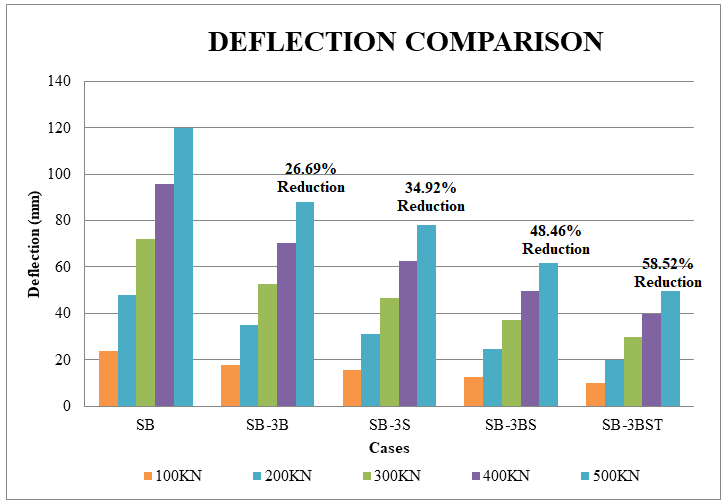
Fig. 12: Deflection comparison for Part A
2) Part B: Comparison in terms of grade change criteria

Fig. 13: Deflection comparison for case SB with different concrete grades
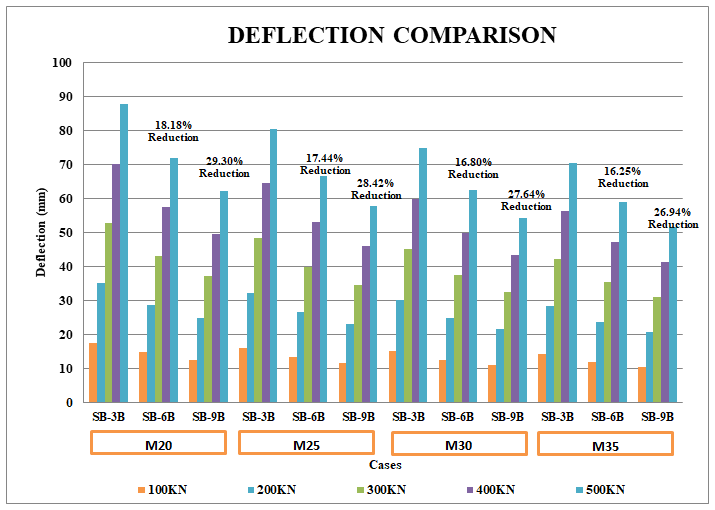
Fig. 14: Deflection using bonding steel plate of 3mm, 6mm and 9mm at base for different grades of concrete
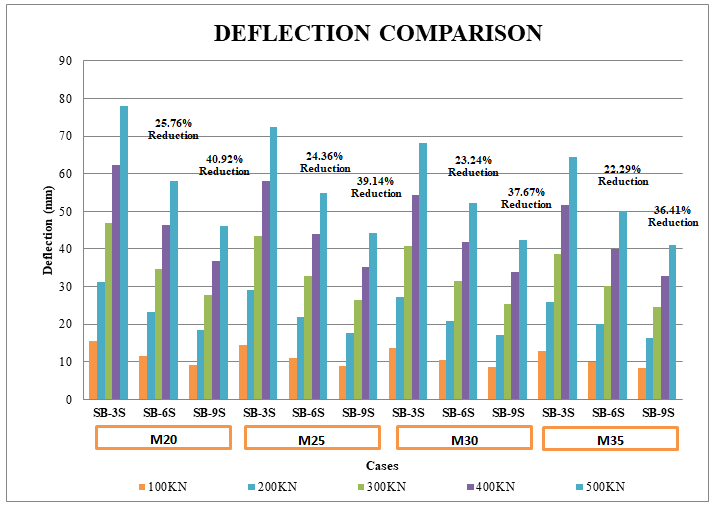
Fig. 15: Deflection using bonding steel plate of 3mm, 6mm and 9mm at two side faces for different grades of concrete
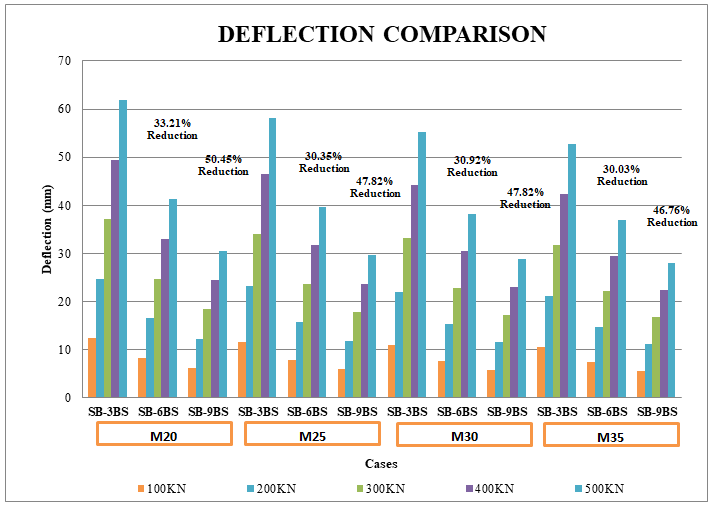
Fig. 16: Deflection using bonding steel plate of 3mm, 6mm and 9mm at base and two side faces for different grades of concrete
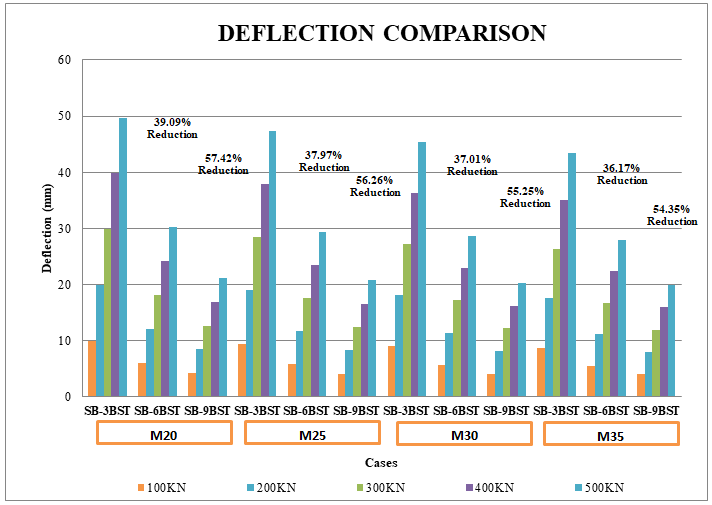
Fig. 17: Deflection using bonding steel plate of 3mm, 6mm and 9mm at base, two side faces and top face for different grades of concrete
Conclusion
A conclusion for comparison of distinct cases involves different models simulation and comparative results have drawn that has provided below with recommendations separately:- A. Conclusions for comparison based on application of with and without usage of bonding steel plate 1) On comparing maximum deflection values, fixing the loading values from 100 KN to 500 KN, concrete grade M20 and 3mm bonding steel plate as constants, for different cases, the deflection values reduced by 26.69 % when using bonding steel plate at base. 2) 34.92 % reduction has observed when using bonding steel plate at two side faces. 3) The maximum deflection values reduced by 48.46 % when using bonding steel plate at base and two side faces. 4) By using the bonding steel plates at base, two side faces and top face, the maximum deflection reduced by 58.52 % which is more reduction as compared to all the cases. This part of the project concluded that the usage of bonding steel plate type retrofitting is more effective for reducing the deflection values. The reduction of deflection is more when covering maximum faces of the beam. B. Conclusions for Comparison based on grade Change Criteria 1) On comparing maximum deflection values, fixing the loading values from 100 KN to 500 KN as constants, for different cases, the deflection values reduced by 10.55 % for M25, 18.35 % for M30 and 24.40 % for M35 when comparing with M20 grade of concrete. 2) When using bonding steel plate at base, for M20 grade concrete 18.18 % reduction for 6mm and 29.30 % reduction observed for 9mm comparing with 3mm steel plate. For M25 grade concrete 17.44 % reduction for 6mm and 28.42 % reduction observed for 9mm comparing with 3mm steel plate. For M30 grade concrete 16.80 % reduction for 6mm and 27.64 % reduction observed for 9mm comparing with 3mm steel plate. For M30 grade concrete 16.25 % reduction for 6mm and 26.94 % reduction observed for 9mm comparing with 3mm steel plate. 3) The maximum deflection values reduced when using bonding steel plate over two side faces by 25.76 % for 6mm and 40.92 % for 9mm comparing with 3mm steel plate for M20 grade concrete. For M25 grade concrete 24.36 % reduction for 6mm and 39.14 % reduction observed for 9mm comparing with 3mm steel plate. For M30 grade concrete 23.24 % reduction for 6mm and 37.67 % reduction observed for 9mm comparing with 3mm steel plate. For M30 grade concrete 22.29 % reduction for 6mm and 36.41 % reduction observed for 9mm comparing with 3mm steel plate. 4) The maximum deflection values reduced when using bonding steel plate at base and two side faces by 33.21 % for 6mm and 50.45 % for 9mm comparing with 3mm steel plate for M20 grade concrete. For M25 grade concrete 30.35 % reduction for 6mm and 47.82 % reduction observed for 9mm comparing with 3mm steel plate. For M30 grade concrete 30.92 % reduction for 6mm and 47.82 % reduction observed for 9mm comparing with 3mm steel plate. For M30 grade concrete 30.03 % reduction for 6mm and 46.76 % reduction observed for 9mm comparing with 3mm steel plate. 5) By using the bonding steel plates at base, two side faces and top face, the maximum deflection reduced by 39.09 % for 6mm and 57.42 % for 9mm comparing with 3mm steel plate for M20 grade concrete. For M25 grade concrete 37.97 % reduction for 6mm and 56.26 % reduction observed for 9mm comparing with 3mm steel plate. For M30 grade concrete 37.01 % reduction for 6mm and 55.25 % reduction observed for 9mm comparing with 3mm steel plate. For M30 grade concrete 36.17 % reduction for 6mm and 54.35 % reduction observed for 9mm comparing with 3mm steel plate. This part of the project concluded that the usage of different grades i.e. higher grade will provide better deflection results that shows the behavior of concrete stiffness is more when using different grades. On other hand, the retrofitting with the bonding steel plate is more effective for reducing the deflection values. The combination of higher concrete grade with increasing thickness of bonding steel plate that covers maximum faces leads to the best result. Application of the complete conclusion is that when designing a beam with reinforcement and section dimension is less, to bear that part of the structure, then we use bonding steel type retrofitting. Also, if the section has passed the strength criteria but the serviceability criterion fails, the member locally can be retrofitted with bonding steel plate type so that the serviceability issues can be fulfilled.
References
[1] Eray Ozbek. (2016). Strengthening of RC Beams with Solid Steel Plates. In Athens Journal of Technology & Engineering (Vol. 3, Issue 4, pp. 291–293). [2] Majid Abdul Ameer, I., Hatif Naji, A., & Ibrahim, A. M. (2020). Finite Element Analysis Of Reinforced Concrete Wide Beams Using Internal Steel Plates As Shear Reinforcement. In Journal of Engineering Science and Technology (Vols. 15–15, Issue 6, pp. 4134–4156). [3] Tjitradi, D., Eliatun, Taufik, S., & Mariamah. (2022). Ansys Modelling Behaviour of The Reinforced Concrete Beam with The Effect of Various Reinforcement Type and Concrete Strength. International Journal of Civil Engineering and Technology (IJCIET), 9–9, 1–13. [4] Havale, S., Desai, Y. N., Desai, H. R., Khade, S. B., Patil, R. N., & Barage, U. D. (2023). FEM Analysis On Stiffened Plates Using Ansys. In International Research Journal of Modernization in Engineering Technology and Science (Vols. 05–05). [5] Tarigan, J., Patra, F. M., & Sitorus, T. (2018). Flexural strength using Steel Plate, Carbon Fiber Reinforced Polymer (CFRP) and Glass Fiber Reinforced Polymer (GFRP) on reinforced concrete beam in building technology. IOP Conference Series. Earth and Environmental Science, 126, 012025. [6] Kisa?a, D., & Furtak, K. (2023). Deflections of Steel Plate-Concrete Composite Beams in the Light of Experimental Studies. Archives of Civil Engineering. [7] Wang, Y. C. (1998). Deflection of Steel-Concrete Composite Beams with Partial Shear Interaction. Journal of Structural Engineering. [8] Bharti, R. D., & Khuswaha, P. N. (2019). Review Paper on RCC Beam with & without Fibre Reinforced Polymer. In International Journal of Trend in Scientific Research and Development (Vols. 4–4, pp. 474–477) [9] Nasr, E. (2019). Strengthening of R.C. Beams Using Different Techniques. In IOSR Journal of Mechanical and Civil Engineering (Vol. 16, Issue 1, pp. 72–82). [10] K S, S., & James, R. M. (2018). Strengthening of RC Beam with Web Bonded Steel Plates. International Journal of Engineering and Techniques, 71. [11] Ozbek, E., Bocek, M., & Aykac, S. (2016). Strengthening of RC Beams with Solid Steel Plates. In Athens Journal of Technology & Engineering (Vol. 3, pp. 291–293). [12] Alfeehan, A. (2014). Strengthening Of R.C. Beams By External Steel Plate Using Mechanical Connection Technique. Journal of Engineering and Sustainable Development, 2, 202–204. [13] Kuddus, M. A., & Azad, I. H. (2017). Laboratory Investigation on Performance of Strengthening Techniques of RCC Beam. American Journal of Civil Engineering and Architecture, 5(1), 25–28. [14] Dawood, M. B., & Al-Saffar, D. H. (n.d.). Flexural behavior of steel concrete composite beam with web openings and strengthened by CFRP laminates. In XIII International Conference on Computational Plasticity. Fundamentals and Applications. [15] Abed, M. J., Nasharuddin, K., Alam, M. A., Zakaria, C., & Fayyadh, M. M. (2012). Damaged Rc Beams With Circular Web Opening Repaired Using Different Configurations Of Bonding Steel Plate. International Journal of Civil Engineering and Technology (IJCIET), 3, 70–83. [16] Nie, J., Fan, J., & Cai, C. S. (2004). Stiffness and Deflection of Steel–Concrete Composite Beams under Negative Bending. In Journal of Structural Engineering (Vols. 130–130, Issue 11, pp. 1842–1851). [17] Rendy Thamrin, (2018). Effect Of Strengthening Method And Development Length On Flexural Strength Of RC Beams With Steel Plates. Journal of Engineering Science and Technology (Vols. 13–13, pp. 3781–3794). [18] Warke, K. S., & Bogar, V. (2023). Experimental And Finite Element Analysis Of Steel-Concrete Composite Beams. In International Research Journal of Modernization in Engineering Technology and Science (Vols. 05–05). [19] Hu, D., Wang, Y., & Ding, F. (2020). Deflection Calculation of Steel-Concrete Composite Beams Considering Effects of Shear Lag and Slip. IOP Conference Series. Materials Science and Engineering, 772(1), 012063. [20] Reyaz, A., Mohsin Thakur, M., & Ahmad, I. (2014). Deflection Control In Rcc Beams By Using Mild Steel Strips (An Experimental Investigation). In IJRET: International Journal of Research in Engineering and Technology (pp. 20–21). [21] Hussein, M., Afefy, H. M. E. D., & Khalil, A. H. a. K. (2013). Innovative Repair Technique for RC Beams Predamaged in Shear. Journal of Composites for Construction, 17(6). [22] E I, E. J., & K, M. (2021). Experimental investigation on Flexural Strength of Steel-Concrete composite beam using Steel plate. In International Research Journal of Engineering and Technology (IRJET) (pp. 4248–4250). [23] Bagherinejad, K., Hosseinpour, E., & Hosseini, S. H. (2015). Evaluation of Rectangular Concrete-Filled Steel-Hollow Section Beam-Columns. Journal of Asian Scientific Research, 5(1), 46–59.
Copyright
Copyright © 2024 Shruti Vaidya, Dr. Umesh Pendharkar. This is an open access article distributed under the Creative Commons Attribution License, which permits unrestricted use, distribution, and reproduction in any medium, provided the original work is properly cited.

Download Paper
Paper Id : IJRASET64082
Publish Date : 2024-08-26
ISSN : 2321-9653
Publisher Name : IJRASET
DOI Link : Click Here
 Submit Paper Online
Submit Paper Online

